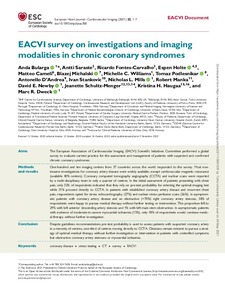EACVI survey on investigations and imaging modalities in chronic coronary syndromes
Bularga Anda; Saraste Antti; Fontes-Carvalho Ricardo; Holte Espen; Cameli Matteo; Michalski Blazej; Williams Michelle C; Podlesnikar Tomaz; D'Andrea Antonello; Stankovic Ivan; Mills Nicholas L; Manka Robert; Newby David E; Schultz-Menger Jeanette; Haugaa Kristina H; Dweck Marc R
https://urn.fi/URN:NBN:fi-fe2021093049004
Tiivistelmä
Aims
The European Association of Cardiovascular Imaging (EACVI) Scientific Initiatives Committee performed a global survey to evaluate current practice for the assessment and management of patients with suspected and confirmed chronic coronary syndromes.
Methods and results
One-hundred and ten imaging centres from 37 countries across the world responded to the survey. Most non-invasive investigations for coronary artery disease were widely available, except cardiovascular magnetic resonance (available 40% centres). Coronary computed tomography angiography (CCTA) and nuclear scans were reported by a multi-disciplinary team in only a quarter of centres. In the initial assessment of patients presenting with chest pain, only 32% of respondents indicated that they rely on pre-test probability for selecting the optimal imaging test while 31% proceed directly to CCTA. In patients with established coronary artery disease and recurrent chest pain, respondents opted for stress echocardiography (27%) and nuclear stress perfusion scans (26%). In asymptomatic patients with coronary artery disease and an obstructive (>70%) right coronary artery stenosis, 58% of respondents were happy to pursue medical therapy without further testing or intervention. This proportion fell to 29% with left anterior descending artery stenosis and 1% with left main stem obstruction. In asymptomatic patients with evidence of moderate-to-severe myocardial ischaemia (15%), only 18% of respondents would continue medical therapy without further investigation.
Conclusion
Despite guidelines recommendations pre-test probability is used to assess patients with suspected coronary artery in a minority of centres, one-third of centres moving directly to CCTA. Clinicians remain reticent to pursue a strategy of optimal medical therapy without further investigation or intervention in patients with controlled symptoms but obstructive coronary artery stenoses or myocardial ischaemia.
Kokoelmat
- Rinnakkaistallenteet [27094]
